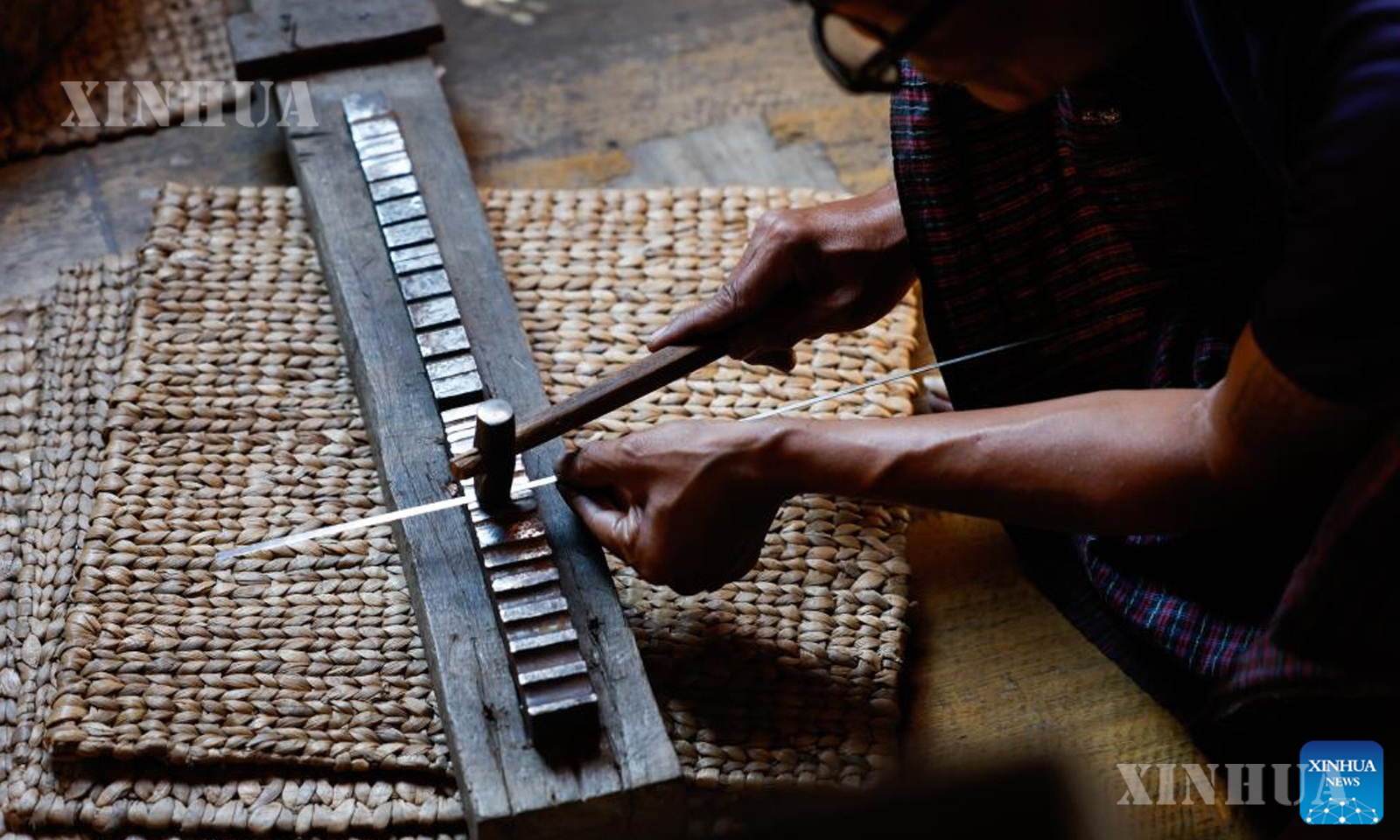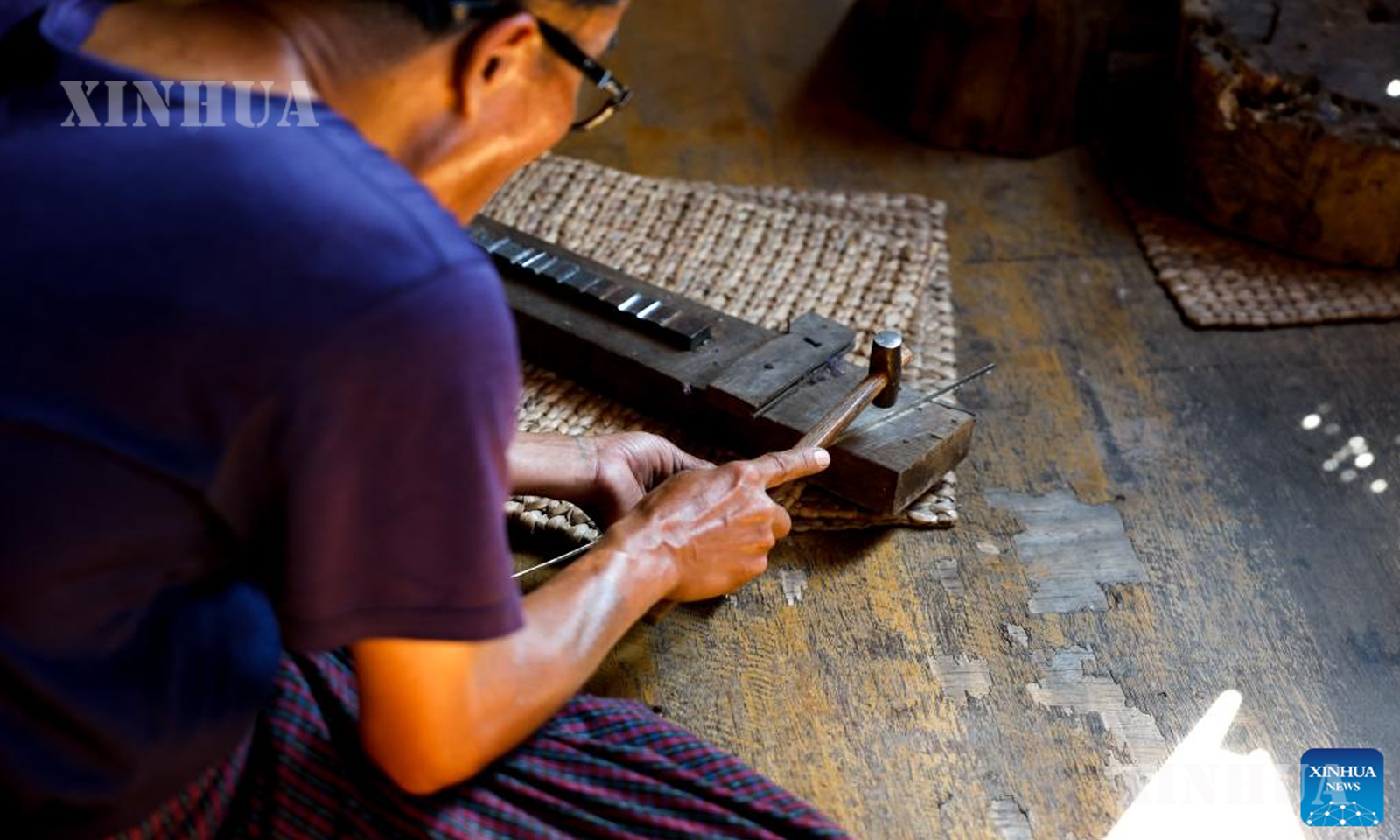Culture & Entertainment
မြန်မာနိုင်ငံ၊ အင်းလေးကန်ရှိ ငွေပန်းထိမ်များက လက်မှုရိုးရာဓလေ့ ဆက်လက်ရှင်သန်ရန် ရုန်းကန်လှုပ်ရှားနေကြရ

ရန်ကုန်၊ နိုဝင်ဘာ ၆ ရက် (ဆင်ဟွာ)
မြန်မာနိုင်ငံ၊ ရှမ်းပြည်နယ်တောင်ပိုင်းတွင် မြူခိုးများဖုံးလွှမ်းနေသော တောင်တန်းများကြား တည်ရှိသည့် အင်းလေးကန်သည် မြန်မာနိုင်ငံ၏ လူစိတ်ဝင်စားမှုအများဆုံး ခရီးသွားနေရာများအနက် တစ်ခုဖြစ်သည်။
အင်းလေးကန်၏ ငြိမ်သက်အေးချမ်းသော ရေပြင်၊ ရေပေါ်ဥယျာဉ်များနှင့် ခြေထောက်ဖြင့်လှေလှော်နေသည့် တံငါသည်များသည် ကမ္ဘာတစ်ဝန်းမှ ခရီးသွားဧည့်သည်များကို ဆွဲဆောင်လျက်ရှိသည်။ အင်းလေးကန်၏ သာယာလှပမှုအပြင် မျိုးရိုးစဉ်ဆက် လက်ဆင့်ကမ်းလာခဲ့သည့် အင်းလေးဒေသ၏ လက်ရာမြောက်သော ငွေထည်လက်မှုပညာရပ်သည်လည်း လူသိများပေသည်။
COVID-19 ကပ်ရောဂါဖြစ်ပွားသည့်အချိန်မှစ၍ နိုင်ငံ၏ နိုင်ငံရေးအခက်အခဲများကြားတွင် တစ်ချိန်က စည်ကားခဲ့သော အင်းလေးကန်ပတ်လည်ရှိ ပန်းထိမ်အလုပ်ရုံများသည် မရေရာသောအနာဂတ်ကို ရင်ဆိုင်ခဲ့ရကြောင်း သိရသည်။
ယခုအခါ နိုင်ငံခြားခရီးသွားဧည့်သည်များ ဝင်ရောက်မှုနည်းပါးလာခြင်းကြောင့် ပြည်တွင်းလက်မှုပညာရှင်များသည် ၎င်းတို့၏လုပ်ငန်းကို ဆက်လက်ရှင်သန်ရန် ရုန်းကန်နေကြရကြောင်း သိရသည်။ ဈေးဆိုင်ငယ်အများစုမှာ ပိတ်ထားရကြောင်း ဒေသခံများ၏ ပြောကြားချက်အရ သိရသည်။
ငွေစင်ထွန်း အင်းလေးရိုးရာငွေပန်းထိမ် အလုပ်ရုံရှိ စင်ပေါ်တွင် လက်ရာမြောက်သော ငွေဖလားများ၊ နားကပ်များ၊ လက်စွပ်များနှင့် လည်ဆွဲများမှာ အရောင်တလက်လက်တောက်ပနေရာ ထိုလက်မှုပစ္စည်းများအားလုံးကို ကျွမ်းကျင်သော လက်မှုပညာရှင်များမှ ပြုလုပ်ထားခြင်း ဖြစ်သည်။
ငွေစင်ထွန်း အင်းလေးရိုးရာငွေပန်းထိမ် အလုပ်ရုံရှိ အရောင်းရဆုံးပစ္စည်းများမှာ ရှမ်း၊ ကချင်ရိုးရာ ဒီဇိုင်းများဖြစ်ကြောင်း အရောင်းကိုယ်စားလှယ် မသဉ္ဇာက ဆိုသည်။
“COVID-19 မတိုင်ခင်က ကျွန်မတို့ဆိုင်ရဲ့ ဖောက်သည်အများစုက နိုင်ငံခြားသားတွေပါပဲ။ အခု အင်းလေးကို နိုင်ငံခြားသား ခရီးသွား အနည်းငယ်ပဲ လာတာပါ။ ကျွန်မတို့ဆိုင်ရဲ့ ငွေထည်ပစ္စည်းတွေအားလုံးက လက်ထည်တွေဖြစ်ပါတယ်” ဟု ၎င်းက အောက်တိုဘာ ၃၁ ရက်က ပြောသည်။
ဆယ်စုနှစ်တစ်ခုကျော်ကြာ ဖွင့်လှစ်ခဲ့သော အဆိုပါဆိုင်သည် တစ်ချိန်က ငွေပန်းထိမ်ဆရာများစွာကို အလုပ်ခန့်ထားနိုင်ခဲ့သော်လည်း ရောင်းအားကျဆင်းသွားသည့်အတွက် ငွေပန်းထိမ်ဆရာများမှာအခြားအလုပ်များကို ရှာဖွေရန် အလုပ်ထွက်ခြင်းများလည်း ရှိကြကြောင်း သိရသည်။
အဆိုပါ ငွေပန်းထိမ်ဆရာများအနက် တစ်ဦးဖြစ်သည့် အသက် ၂၂ နှစ်အရွယ် ကိုအောင်သူရှိန်သည် လွန်ခဲ့သည့် ၂ နှစ်ခန့်က ငွေစင်ထွန်း အင်းလေးရိုးရာငွေပန်းထိမ်၌ ပန်းထိမ်ဆရာလက်အောက်တွင် သင်တန်းမတက်မီ အလုပ်ရုံတွင် အလုပ်သင်အနေဖြင့် လုပ်ကိုင်ခဲ့ကြောင်း သိရသည်။
“အစကတော့ ကျွန်တော့်အနေနဲ့ ဒီအလုပ်ကို သိချင်လို့စပ်စုရုံပဲ ကြည့်ခဲ့တာ။ နောက်ပိုင်းကျတော့ ကျွန်တော့်အနေနဲ့ ဆရာ့ဆီကနေ ဒီပညာရပ်ကို သင်ယူခဲ့ပါတယ်။ ပန်းထိမ်ဆရာတစ်ယောက်ဖြစ်ဖို့အတွက် နာရီပေါင်းများစွာကြာတဲ့အထိထိုင်ပြီး မျက်စိတွေညောင်းလာတဲ့အထိ အာရုံစူးစိုက်ရတယ်ဆိုတာကို သိလာခဲ့တယ်” ဟု ၎င်းက အတိတ်ကို ပြန်ပြောပြသည်။
ယခုအချိန်တွင် ၎င်းအနေဖြင့် လက်ရာရှုပ်ထွေးဆန်းပြားသော နားကပ်များ၊ လက်စွပ်များနှင့် လည်ဆွဲများကို လက်ဖြင့်ပင် အနုစိတ်ပြုလုပ်နေပြီဖြစ်ကြောင်း သိရသည်။
“ကျွန်တော့်ဘဝတိုးတက်ဖို့အတွက် ဒီအသက်မွေးဝမ်းကျောင်းပညာရပ်ကို ကျွန်တော်ရွေးချယ်ခဲ့တယ်။ “အစတုန်းကတော့ အမှားတွေ အများကြီးလုပ်မိလို့ မကြာခဏ အပြစ်တင်ခံရပေမဲ့ ကျွန်တော် ဆက်ပြီး ကြိုးစားလေ့လာခဲ့ပါတယ်” ဟု ၎င်းက ပြောသည်။
အောင်မြင့်မိုရ် အင်းလေးရိုးရာငွေထည်နှင့် ချည်ထည်လုပ်ငန်း၏ အလုပ်ရုံပိုင်ရှင် ဦးအောင်မြတ်မင်းက အလားတူ ဖြစ်ရပ်ကို ပြောကြားခဲ့သည်။
“ကျွန်တော့်အနေနဲ့ ဆွဲကြိုးနဲ့ ဟန်းချိန်းကို လုပ်လာခဲ့တာ ၁၀ နှစ်ကျော်ခဲ့ပြီ” ဟု ၎င်းကပြောသည်။
“ခရီးသွားဧည့်သည်တွေ နည်းလာတာနဲ့အမျှ ငါးပုံသဏ္ဌာန်အမှတ်တရပစ္စည်းတွေနဲ့ လက်စွပ်တွေက အရင်ကဆိုရင် ရောင်းအားအကောင်းဆုံး ဖြစ်ခဲ့ပေမဲ့ အခုအချိန်မှာတော့ ရောင်းအားကျနေတယ်” ဟု ၎င်းက ဆိုသည်။
“ငွေပန်းထိမ်လုပ်ငန်းက စိတ်ရှည်သည်းခံမှုနဲ့ ကျွမ်းကျင်မှုလိုအပ်တယ်။ အင်းလေးက ငွေထည်တွေက ငွေအရည်အသွေးက ကောင်းတာပေါ့။ ငွေထည်တွေကို အရည်ကြိုပြီးလောင်းတဲ့ မိုလောင်းထည်တွေရှိပေမဲ့ လက်နဲ့လုပ်တဲ့ လက်ရာက ဈေးပိုများသလို တန်ဖိုးလည်းပိုထားကြပါတယ်” ဟု ၎င်းက ဖြည့်စွက်ပြောကြားသည်။
ခိုင်ရွှေဝါ အင်းလေးရိုးရာ ငွေပန်းထိမ် လက်မှုအလုပ်ရုံတွင် ဆယ်စုနှစ် နှစ်ခုနီးပါးကြာ လုပ်ကိုင်ခဲ့ကြောင်း အသက် ၅၈ နှစ်အရွယ် ဒေါ်နန်းရွှေအုန်းက ၎င်း၏ မိသားစုလုပ်ငန်းနှင့် ပတ်သက်၍ ရှင်းပြသည်။
“ကပ်ရောဂါမဖြစ်ခင်တုန်းက ကျွန်မရဲ့ လုပ်ငန်းမှာ ပန်းထိမ်သမား ၁၂ ဦးနဲ့ အရောင်းဝန်ထမ်း ၇ ဦးရှိတယ်။ အခုတော့ ပန်းတိမ်သမား ၂ ဦးနဲ့ အရောင်းဝန်ထမ်း ၂ ဦးပဲရှိတော့တယ်” ဟု ၎င်းကပြောသည်။
၎င်း၏ဆိုင်တွင် အင်းလေးနှင့် ရှမ်းရိုးရာဒီဇိုင်းများဖြင့် ပြုလုပ်ထားသည့် ငွေထည်ပေါင်း ၃၈၀ ဝန်းကျင်ရှိကြောင်းဆိုသည်။
“နိုင်ငံခြားသားဧည့်သည်တွေကတော့ လက်နဲ့လုပ်တဲ့ အထည်တွေကို စိတ်ဝင်စားကြတယ်။ ငွေထည်ကို အစကနေ အဆုံးအထိ လုပ်ပြခိုင်းတယ်။ သူတို့ကိုယ်တိုင်လည်း အထည်လုပ်တဲ့အထဲဝင်ပါတယ်။ တစ်နေကုန် အလုပ်ရုံမှာ ထိုင်စောင့်ပြီး လုပ်တာရှိတယ်။ တအားပျော်ဖို့ကောင်းတယ်။ အဲဒီတုန်းက” ဟု ၎င်းက ပြောသည်။
“ကျွန်မတို့ရဲ့ ဖောက်သည်တွေက တရုတ်နိုင်ငံ၊ အီတလီနိုင်ငံ၊ ပြင်သစ်နိုင်ငံနဲ့ တောင်ကိုရီးယားနိုင်ငံက လူတွေများပါတယ်။ တရုတ်နိုင်ငံသားဧည့်သည်တွေက ငွေကို ကျောက်စိမ်းနဲ့ လုပ်ထားတဲ့ အထည်တွေကို အရမ်းကြိုက်ကြတယ်” ဟု ၎င်းက ပြောသည်။
ယနေ့တွင် အဆိုပါမိသားစု၏ အမွေအနှစ်ကို ငွေထည်လုပ်ငန်းလုပ်ရင်း ကြီးပြင်းလာသည့် အသက် ၂၉ နှစ်အရွယ် သားဖြစ်သူ ကိုအောင်မြတ်သူကို လက်ဆင့်ကမ်းထားကြောင်း သိရသည်။
ကိုအောင်မြတ်သူက “ကျွန်တော်ဒီလုပ်ငန်းကို ကလေးဘဝကတည်းက လုပ်ကိုင်ခဲ့တာပါ။ ဆွဲကြိုးတွေ၊ ဟန်းချိန်းတွေ၊ လက်စွပ်တွေကို ဒီဇိုင်းအသစ်တွေ ဖန်တီးရတာကို ကြိုက်ပါတယ်” ဟုပြောသည်။
“ကျွန်တော့်အနေနဲ့ ဒီမိသားစုလုပ်ငန်းကို ဆက်ပြီးရှင်သန်အောင်လုပ်မှာပါ။ အင်းလေးကန်ကို မကြာခင်မှာ နိုင်ငံခြားသားခရီးသွားဧည့်သည်တွေ များများလာမယ်လို့မျှော်လင့်မိပါတယ်” ဟု ကိုအောင်မြတ်သူက ပြောသည်။ (Xinhua)

မြန်မာနိုင်ငံ၊ ရှမ်းပြည်နယ်၊ ညောင်ရွှေမြို့၊ အင်းလေးကန်ရှိ ငွေထည်ပြုလုပ်နေသည့် ပန်းထိမ်သမားတစ်ဦးကို ၂၀၂၅ ခုနှစ်၊ အောက်တိုဘာ ၃၁ ရက်က တွေ့ရစဉ် (ဆင်ဟွာ)
…………………
English Version
Feature: Silversmiths on Myanmar’s Inle Lake struggle to keep handcrafted tradition alive
YANGON, Nov. 3 (Xinhua) — Nestled among the misty hills of southern Shan state, Inle Lake has long been one of Myanmar’s most treasured tourist destinations.
Its tranquil waters, floating gardens, and leg-rowing fishermen have captivated travelers from around the world. Yet beyond its serene beauty, Inle is renowned for its exquisite silver craftsmanship, a tradition passed down through generations.
Since the COVID-19 pandemic and amid the country’s political hardships, however, the once-bustling silversmith workshops around the lake have faced an uncertain future.
With foreign visitors, their main customers, now scarce, local artisans are struggling to keep their craft alive. Many small shops have shut their doors, local residents said.
At the Ngwe Sin Tun Traditional Inle Lake Silversmith Workshop, shelves still shimmer with finely crafted silver bowls, earrings, rings, and necklaces, all handmade by skilled artisans.
Salesperson Ma Thinzar said their bestsellers are traditional designs inspired by Shan and Kachin motifs.
“Before COVID-19, most of our customers were foreigners,” she said on Friday. “Now, only a few foreign tourists come to Inle. All of our products are handmade.”
The shop, open for over a decade, once employed many silversmiths, but several left to find other work as sales declined. A few young people remain determined to preserve the heritage.
One of them is 22-year-old Aung Thu Shein, who began at Ngwe Sin Tun Traditional Inle Lake Silversmith Workshop as a greeter before training under a master silversmith about two years ago.
“At first, I was just curious, watching them work,” he recalled. “Later, I learned the craft from a master. Being a silversmith requires patience, sitting for long hours and straining your eyes.”
He now crafts intricate earrings, rings, and necklaces by hand. “I chose this career to improve my life,” he said. “At the beginning, I made many mistakes and was often scolded, but I kept learning.”
Across the lake, Aung Myat Min, owner and silversmith of Aung Myint Moh Traditional Inle Silversmith Workshop, shared a similar story. “I’ve been making necklaces and hand chains for over 10 years,” he said.
“With fewer tourists, sales have dropped, though fish-shaped souvenirs and rings remain bestsellers,” he said.
“Silversmithing takes patience and skill, and even with molded products available, handmade pieces still hold special value,” he added.
At Khaing Shwe War Traditional Inle Silversmith Handicraft Workshop, 58-year-old Daw Nan Shwe Ohn has spent nearly two decades running her family business.
Before the pandemic, her workshop was lively, employing 12 silversmiths and seven salespeople. “Now, we only have two silversmiths and two salespersons,” she said.
Her shop once offered around 380 silver designs featuring traditional Inle and Shan motifs. “Foreign visitors even joined our artisans to experience the crafting process,” she said.
“Our customers came from China, Italy, France, and South Korea. Chinese tourists especially liked silver combined with jade,” she said.
Today, the family’s legacy continues through her son, Aung Myat Thu, 29, who grew up surrounded by silver. “I’ve been involved since childhood,” he said. “I enjoy creating new designs, necklaces, hand chains, and rings.”
“I’ll continue this craft and keep our family business alive. I just hope more foreign visitors return to Inle Lake soon,” Aung Myat Thu said. ■






